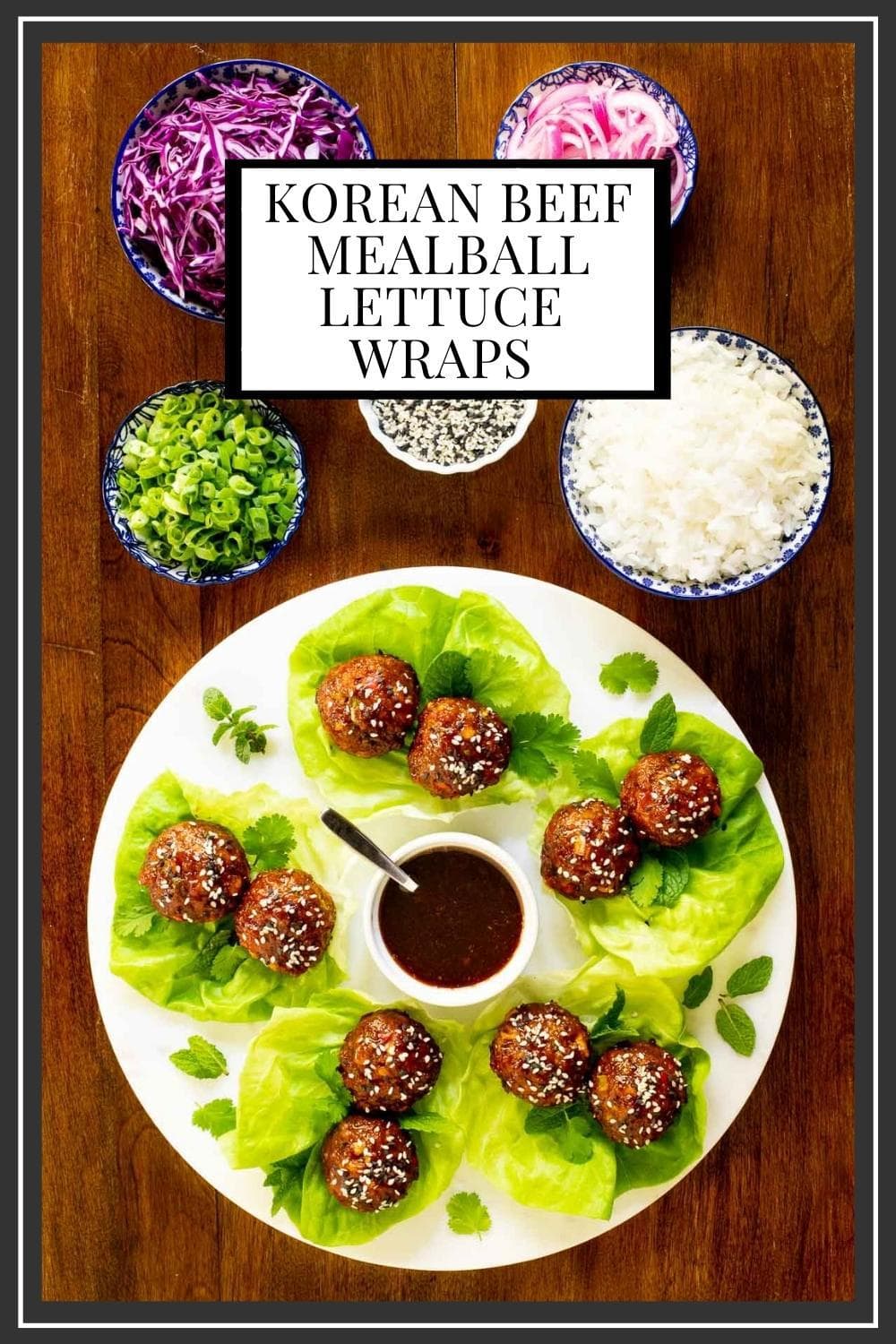Korean Meatball Lettuce Wraps – The Café Sucre Farine
This post may contain affiliate links. For more information, see our privacy policy.
Looking to eat a little lighter and leaner? These Korean Meatball Lettuce Wraps are easy, healthy and so delicious! The meatballs also make a fabulous appetizer that will disappear in the blink of an eye!
A recipe from the New York Times Cooking for Korean Barbecue Style Meatballs came through my email recently. The picture was so enticing I quickly clicked the link. But when the reviews reported things like “dry and bland”, “boring”, “not Korean”, “a real disappointment” … I decided to come up with my own recipe. Instead of using the meatballs in a rice bowl (as in the NYTimes recipe), I took a lighter approach and made these Korean Meatball Lettuce Wraps. I’m hoping you’ll enjoy them as much as we have!
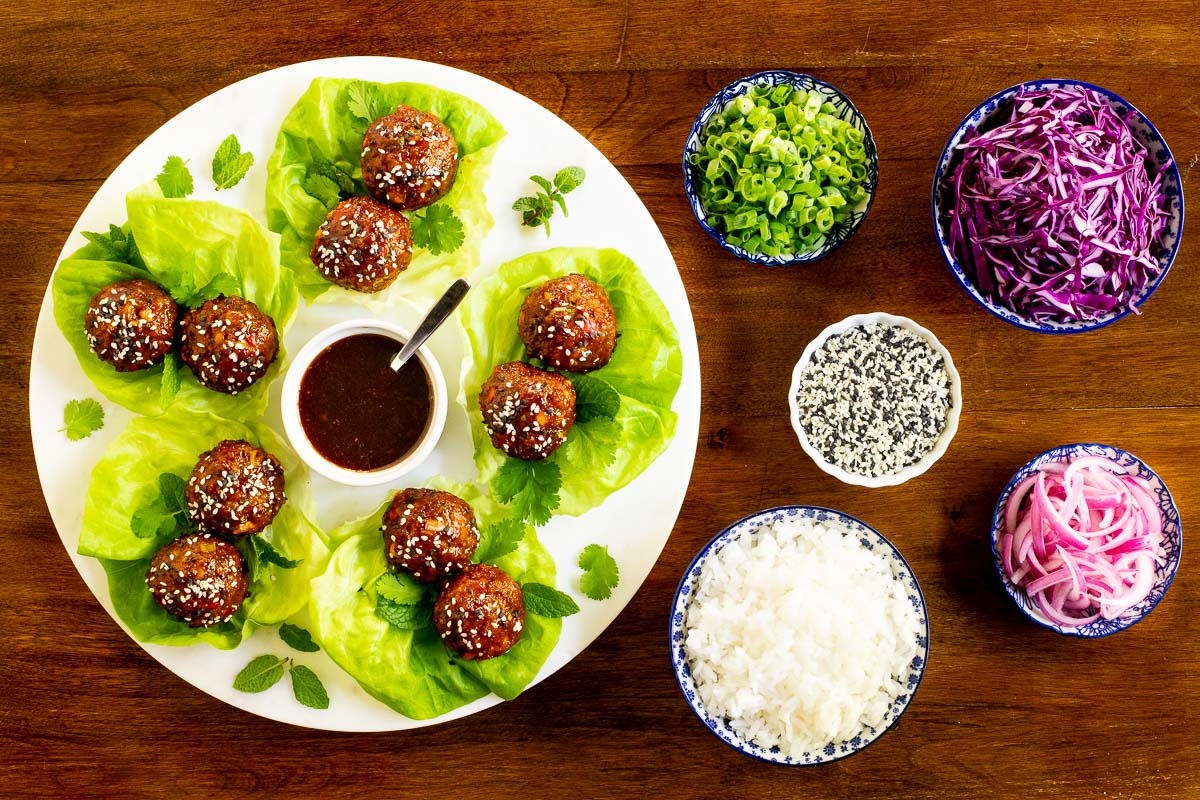
I used my recipe for Strawberry Balsamic Glazed Meatballs as a base for these meatballs, swapping out ground beef for the chicken, increasing the veggies (bell pepper and scallions) and switching to a Korean flavor profile with the addition of fresh ginger and Gochujang. I also added some fun condiments like quick-pickled red onions, shredded red cabbage, tuxedo (black and white) sesame seeds and sliced scallions. A bowl of steamed rice is another option for a little extra heartiness.
What is Gochujang?
You might be wondering “what in the world is Gochujang?”. Gochujang(pronounced go·chu·jang) is a fundamental ingredient used in Korean cuisine. It’s savory, spicy and sweet all at the same time that adds delicious, complex umami flavor boost to soups, sauces, salad dressings, snacks, grilled entreés… and these Korean Meatball Lettuce Wraps!
Gochujang is a spicy chile bean paste. You’ll find it either in a squeeze bottle (thinner, like a sauce) or in a little tub (thicker paste version). It’s made from chili powder, glutinous rice, fermented soybean powder, barley malt powder and salt.
Where can I find Gochujang?
If you’re not familiar with Gochujang, you might think that’s it’s difficult to find. Actually, in the last five years, it’s become such a beloved ingredient around the world, that most regular grocery stores are now carrying it. Look for it in the international aisle where you normally find soy sauce and other Asian ingredients. You can also order it online.
Is there anything I can use as a substitute for Gochujang?
Although Gochujang has it’s own unique flavor and I would highly recommend looking for it, in a pinch, Sriracha or chili garlic sauce could be subbed. Food.com also has a recipe called Substitute Gochujang in a Pinch.

A delicious glaze and sauce, all in one!
There’s lots of flavor in these Korean meatballs but the glaze/sauce is definitely the crowning glory. It’s easy to throw together while the meatballs bake. Simply combine soy sauce, honey, brown sugar, rice vinegar, Gochujang and a splash of sesame oil. When the meatballs are almost finished baking, they’re dipped in the delicious sauce then popped back in the oven for an additional 5 minutes. The heat helps the flavorful glaze to adhere and the meatballs to emerge from the oven golden and glistening.
The remainder of the glaze can be used for a sauce to spoon over the meatballs. It’s sweet, spicy, salty and so delicious!
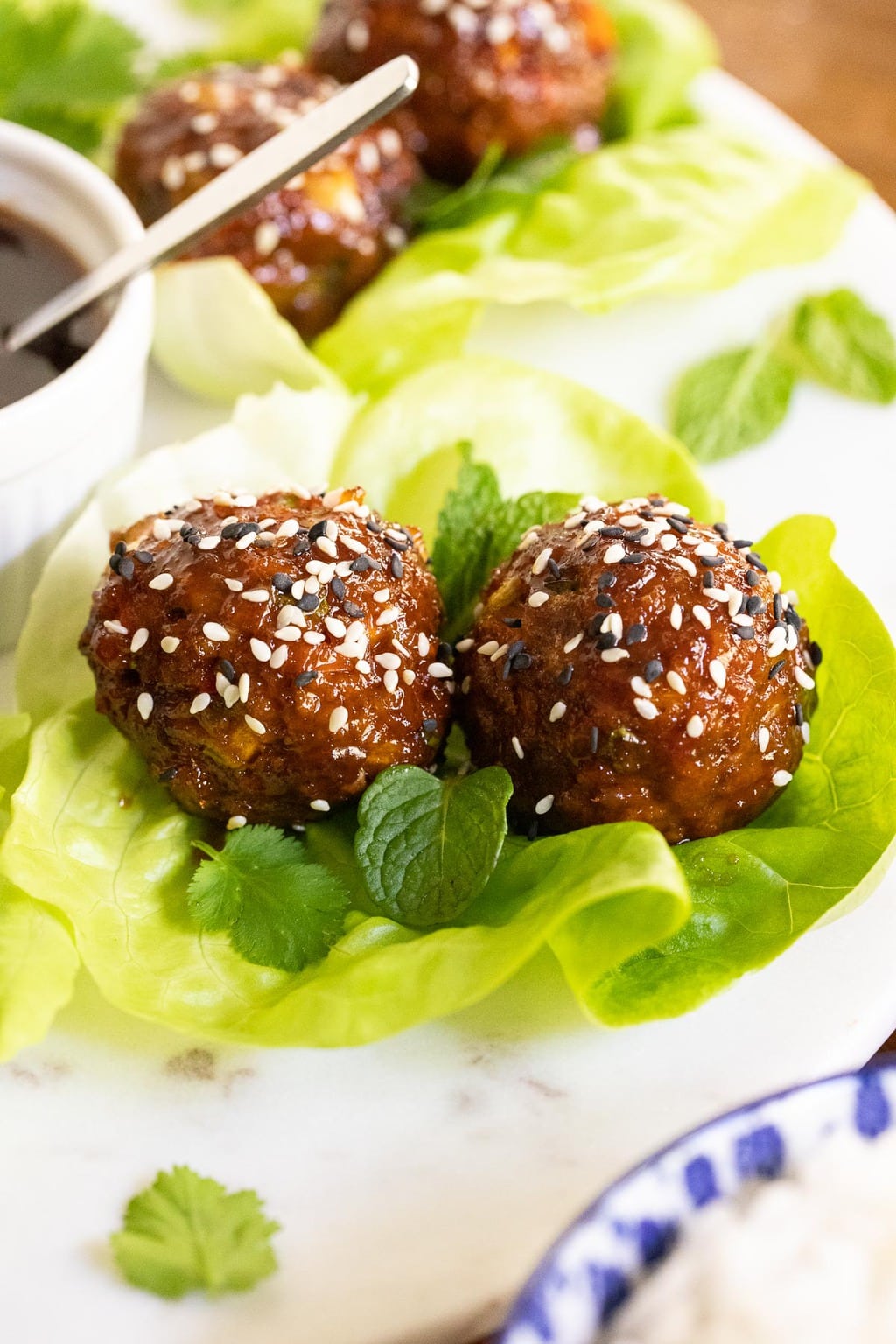
How to Serve these Korean Meatball Lettuce Wraps.
We enjoyed them wrapped in large Boston, Bibb or Romaine lettuce leaves but they would also be fabulous in rice bowls.
Add side condiments like shredded purple cabbage, sliced cucumbers, sesame seeds, chopped cashews or peanuts, bean sprouts, scallions, shredded carrots and/or pickled red onions and let everyone help themselves.
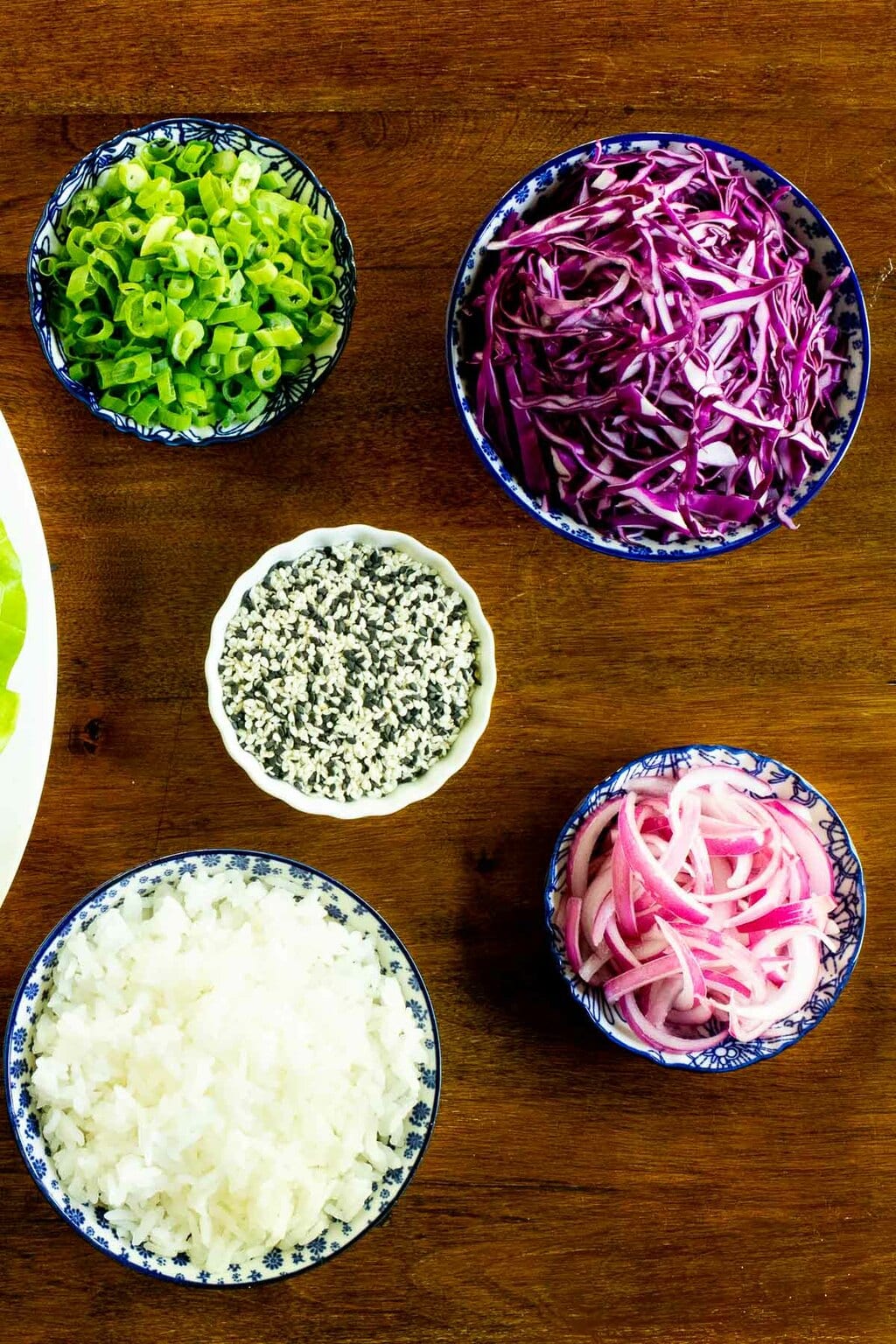
We also enjoy pickled red onions with these meatballs. This is a super quick and easy recipe that adds a beautiful splash of color and is a delicious acidic flavor complement to the meatballs.
To make this versatile condiment simply cut a small peeled red onion in half and then into thin wedges. Combine the onion slices with 2 teaspoons rice vinegar, 1 teaspoon sugar and ¼ teaspoon salt in a small storage container with a tight-fitting lid. Cover and shake well to distribute the ingredients. The onions will take 30-60 minutes to begin to transform from deep purple to a brilliant pink. Onions can be refrigerated at this point and will continue to brighten in color for the next 12-24 hours.
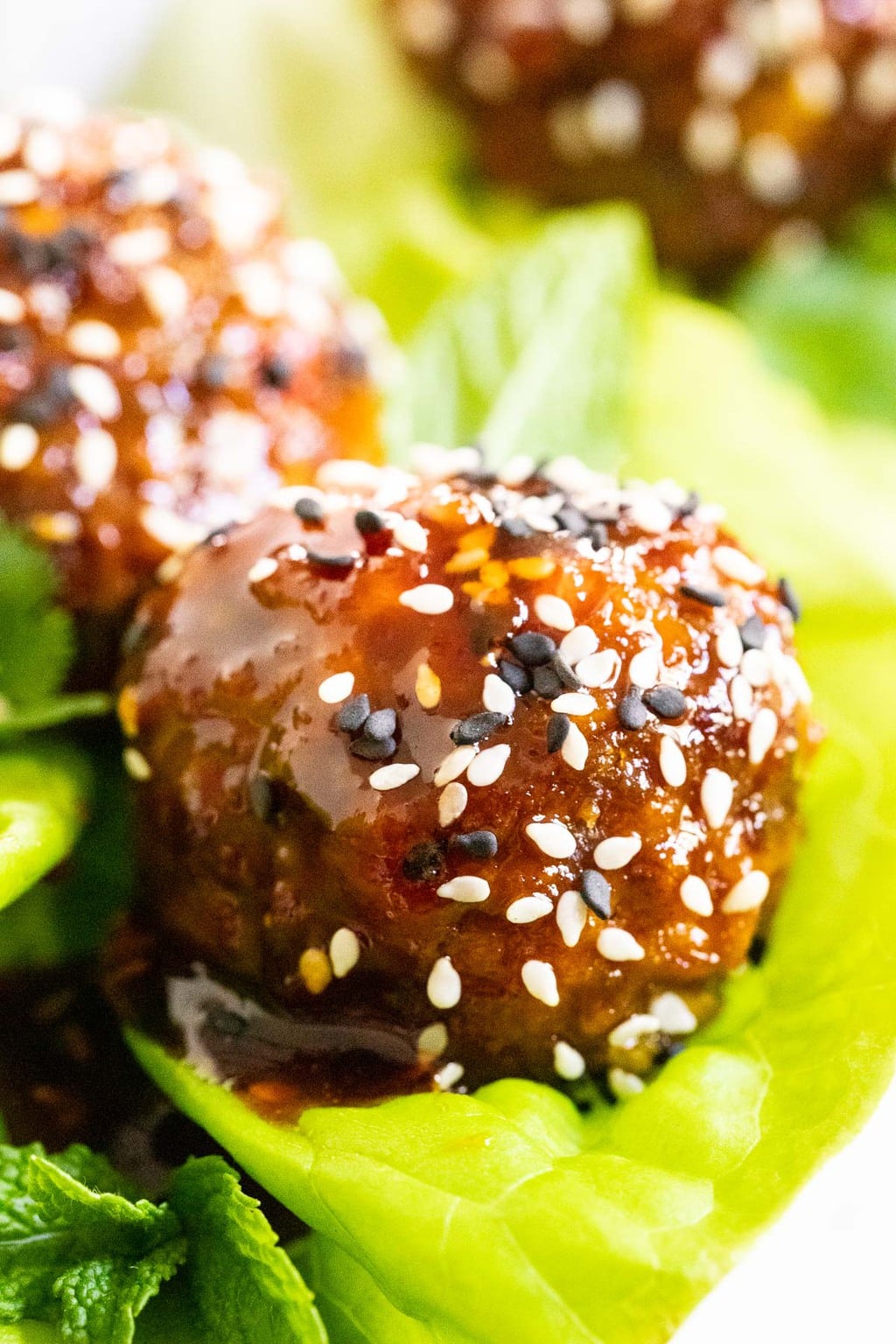
Check over the ingredients and add whatever you don’t have to your next shopping list. Make them as spicy or mild as your taste dictates. These Korean Meatball Lettuce Wraps will be popular with adults and kids alike!
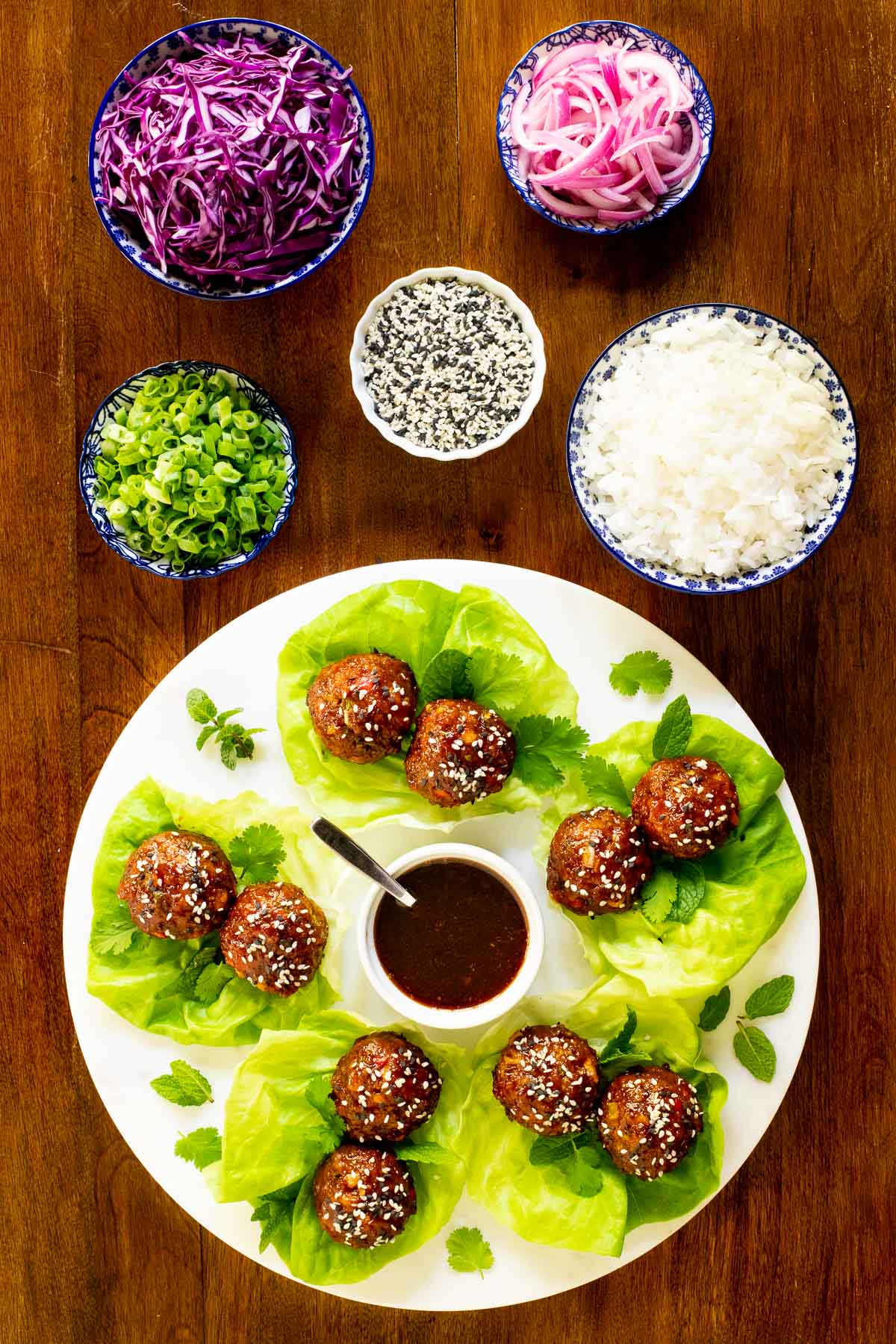
Café Tips for making these Korean Meatball Lettuce Wraps
- I use 93% lean ground beef for these meatballs to keep them a little healthier. If you use ground beef with a higher fat level, I recommend transferring the meatballs to a clean sheet pan before adding the glaze as there will be a decent amount of fat accumulated on the original pan. The glaze will set better without the fat.
- Different brands of Gochujang can have varying levels of heat. I designed the recipe so you can tailor the heat to your own taste. The meatball recipe calls for 2 tablespoons of Gochujang which adds a medium amount of spicy heat. You could add less if you like things milder in heat. I would also recommend adjusting the sauce to your preference. The Gochujang is added after the sauce is simmered so you can start with 1 tablespoon, take a taste, then add more, if desired.
- I used the mini bell peppers in a variety of colors for my meatballs but one large bell pepper in yellow, orange, or red will also work.
- The bell pepper needs to be diced nice and small for this recipe. I used my Vidalia Chop Wizard to make short work of this job. It’s one of my favorite kitchen tools and can be used with so many fruits and veggies. Whenever Scott hears the “whack, whack, whack” of the chopper, he knows something delicious is in the making. I use it for apples, pears, onions, peppers, potatoes, carrots, cucumbers, squash of all varieties, jicama, sweet potatoes, radishes, celery… so many things!
- These meatballs can be made in advance, cooled and refrigerated. To rewarm, brush the meatballs with a little of the sauce and warm in the oven for 10 minutes at 250˚F.
- I like to use a 3 tablespoon cookie scoop to portion out consistent size meatballs. These scoopers are also great for cookie dough and lots of other things.
- I spray my scooper with non-stick cooking spray to make scooping super easy.
- To serve these Korean Meatball Lettuce Wraps as an appetizer, scoop up smaller portions (about 2 tablespoons) and roll into balls. Bake as directed, shaving 1-2 minutes off of the total time. Serve on a platter with a drizzle of the sauce on small lettuce leaves
Thought for the day:
There is surely a future hope for you,
and your hope will not be cut off. Proverbs 23:18
What we’re listening to for inspiration:
If you enjoyed this recipe, please come back and leave a star rating and review! It’s so helpful to other readers to hear others’ results and ideas for variations.
Korean Meatball Lettuce Wraps
Looking to eat a little lighter and leaner? These Korean Meatball Lettuce Wraps are easy, healthy and so delicious! The meatballs also make a fabulous appetizer that will disappear in the blink of an eye!
:

Prep Time:
25 mins
Cook Time:
20 mins
Total Time:
45 mins
Servings: 6
Calories: 356 kcal
Ingredients
For the meatballs:
-
1
pound
ground beef -
6
scallions
finely chopped -
1
cup
finely diced bell pepper
red, orange or yellow (or a combination) -
1
tablespoon
finely grated fresh ginger -
3
medium cloves garlic
finely minced -
½
cup
panko crumbs -
1
large egg -
1-2
tablespoons
Gochujang
Korean chili paste -
1
teaspoon
kosher salt -
sesame seeds
thinly sliced green onions and cilantro for garnish
For the sauce:
-
½
cup
honey -
¼
cup
low sodium soy sauce -
1-2
tablespoons
gochujang
Korean chili paste -
2
tablespoons
rice vinegar -
2
tablespoons
brown sugar
I use dark but light will also work -
1
teaspoon
sesame oil
Instructions
For the meatballs:
-
Line a sheet pan with parchment paper or foil. If you use foil, spray it lightly with baking spray or rub it with a bit of oil. If using parchment, use a large enough piece so that the sides extend slightly over the edges of the pan.
-
Combine the ground beef, scallions, bell pepper, ginger, garlic, panko, egg, Gochujang and kosher salt in a large bowl. Using your hands, mix until combined but don’t overwork the meat mixture.
-
Using an ice cream scoop or spoon, scoop into approximately 3 tablespoon size portions. With slightly wet hands, roll the scoops of meat into balls with the palm of your hand. Arrange them on the prepared baking sheet. Refrigerate the meatballs (covered with plastic wrap) for 30 minutes (or up to 8 hours). You can also freeze the meatballs at this point.
-
Preheat the oven to 425˚F with a rack positioned near the top of the oven.
-
Bake for 15 minutes. (If meatballs are frozen, give them an extra 5-6 minutes.)
-
Remove meatballs from the oven. Using a fork, dip each meatball into the sauce to coat then return to the baking pan. Bake for another 4-5 minutes until meatballs are nicely glazed.
-
Serve with the extra sauce along with Bib, Boston or Romaine lettuce leaves and optional garnishes of rice, shredded red cabbage, thinly sliced cucumber, pickled red onions, scallions, cashews, sesame seeds and/or herb leaves (cilantro, basil, mint).
For the sauce:
-
While the meatballs are baking, make the sauce. Combine all sauce ingredients except for the Gochujang in a small saucepan and stir.
-
Bring to a boil and cook for 4-5 minutes until the sauce begins to thicken. Add 1 tablespoon of the Gochujang. Taste and add more to the desired heat level. Set sauce aside.
Recipe Notes
See Café Tips above in post for more detailed instructions and tips. Recipe makes 16-20 meatballs, depending on the size.
Serves 6 with 3 meatballs per serving
Calories 356kcal
Fat 17g
Saturated fat 6g
Cholesterol 81mg
Sodium 846mg
Potassium 369mg
Carbohydrates 36g
Fiber 1g
Sugar 29g
Protein 16g
Vitamin A 937%
Vitamin C 35%
Calcium 47%
Iron 2%
The Café Sucre Farine is a participant in the Amazon Affiliate Program. The Amazon Affiliate Program is designed to provide a means for sites to earn advertising fees by advertising and linking to products on Amazon. The price you pay as a consumer does not change.
